Як ми пам’ятаємо, однією з причин падіння Авдіївки були масові вильоти авіації Росії з бомбами.
Вперше з початку великої війни штаби росіян змогли організувати одночасні прольоти десятків бортів. Були окремі дні, коли на українські позиції приходило по 150-200 коригованих бомб. І періодично це були дійсно великі боєприпаси. Наприклад, на завод у Красногорівці впала ФАБ-1500.
А півтонні бомби (ФАБ-500) використовувалися масово. Попри те, що російський модуль планування та корекції ще не досяг точності західного аналога JDAM з влучанням “у близько 5 метрів”, для ударів по забудові російські авіабомби виявилися ефективними.
Просто руйнуючи будівлі, розбиваючи дороги, під’їзди, шляхопроводи – від російської авіації страждала логістика ЗСУ та постачання на “останньому кілометрі”.
При цьому росіяни змушені були і самі “розкриватися” – Повітряні сили ЗСУ за останні місяці заявляли про 13 збитих російських бойових літаків: бомбардувальників Су-34, а також винищувачів Су-35, які їх супроводжували.
Бомби часів Афганістану
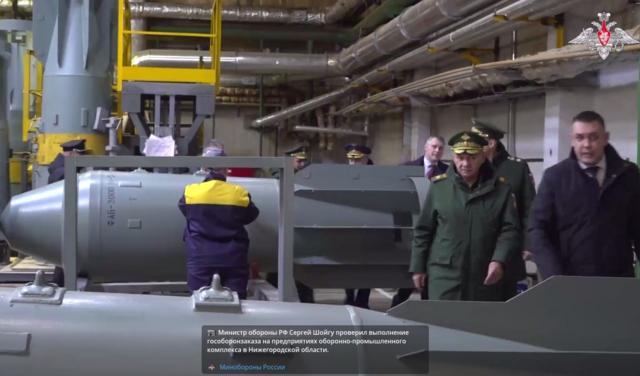
АВТОР ФОТО,МІНОБОРОНИ РФ Підпис до фото, Шойгу біля ФАБ-3000
Після відходу української армії з Авдіївки колапсу фронту не сталося, Росія увійшла у позиційні бої.
Водночас тепер російський пропагандистський канал Міноборони РФ “Звезда” відрапортував про те, що Шойгу відвідав одне з їхніх підприємств ВПК.
Це 53-й арсенал у Нижньогородський області, де росіяни переробляють старі боєприпаси та виробляють нові бомби, снаряди, ВОГи.
У сюжеті йдеться про нарощування виробництва ФАБ-1500 удвічі, але найбільшого резонансу він досяг через новину про відновлення проєкту ФАБ-3000.
Ці авіаційні бомби мають 1400 кг вибухівки – серйозний вантаж і засіб ураження.
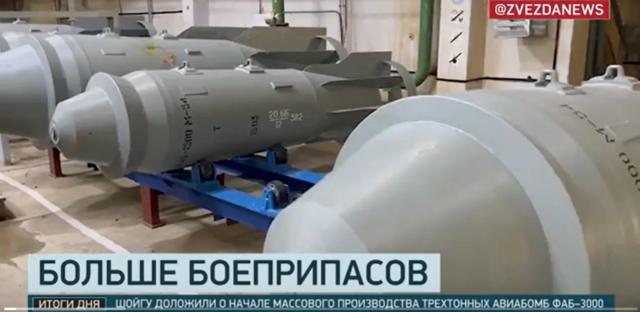
АВТОР ФОТО,СКРИН ВІДЕО “ЗВЕЗДА”
Такі бомби радянська армія застосовувала під час вторгнення до Афганістану у 1980-х. Вона била ними по лазуритних шахтах Куран-о-Мунджан, по військах моджахедів, які брали в облогу Кабул, по тодішніх укріпрайонах ісламістів.
У сучасній Росії ці ФАБи, перероблені у КАБи (“керовані авіабомби”), тепер називають “цар-бомбами”, хоча по суті це чавун, до якого намагаються приєднати комплект крил для планування і GPS.
Поки що тривають експерименти з передсерійними партіями. Йдеться не просто про те, щоб приєднати до бомби великі крила, і тоді важкий боєприпас полетить, куди треба. Натомість потрібно врахувати багато інженерних моментів.
Суцільна зона враження у бомби ФАБ-3000 – 35 метрів. Зона важких контузій та руйнувань – 150 метрів. Якщо є обладнані позиції з перекриттями, інженерними обкладаннями та бруствером, то зона ураження менша.
Тому свого часу великі ФАБи й зняли з озброєння, випробувавши “за річкою” (неофіційна назва війни в Афганістані, так у 1980-х називали перехід за річку Амудар’я на афгано-узбецькому кордоні та через річку Пяндж – на афгано-таджицькому. – Ред.).
Легка піхота афганців, що змінювала позиції та ховалася в горах, виявилися для радянських авіабомб не найпростішою ціллю.
Єдиним носієм цього засобу в РФ є бомбардувальник Ту-22М3 – через розміри бомболюків і нюанси кріплення.
Більше носіїв “тритонних” бомб у Москви немає.
Російський “воєнний блогер” Fighterbomber зазначає, що крім Ту-22МЗ теоретично ФАБ-3000 може нести ще й Су-34 – по дві бомби з кріпленням під крилами.
Утім і Су-34, і Ту-22 з важкими авіабомбами втрачають у маневреності, що робить їх вразливими для ППО.
Є ще старі стратегічні бомбардувальники Ту-16. Але ці літаки давно списані. Ту-16 розробили у 1950-х, їх вивели з експлуатації у 1990-х.

АВТОР ФОТО,“ВОЕННОЕ ОБОЗРЕНИЕ” Підпис до фото, Ту-16
Переробка інших літаків позначиться на вартості бомбометання ФАБ-3000 і згодом виведе частину машин з експлуатації.
Тобто у стратегічному плані росіянам вигідніше скидати півтонні ФАБ-500, чим вони зараз і займаються.
Схожу оцінку дає й Fighterbomber. “Щодо ФАБ-3000 у мене є легке здивування від потреби у ній. Цілей під неї немає. Під неї потрібно “пиляти” УМПК з нуля і це вже буде насправді цілий літак на бомбі. І ось його вже буде чудово видно будь-якому ЗРК”, – пояснює блогер.
За його словами, оптимальний боєприпас для УМПК – це калібр 500 кг. У різних варіантах: касетному, запальному, ядерному, фугасному. Збільшення потужності у рази не дає збільшення зони ураження в рази. Все одно потрібна точність.
Поодинока ФАБ-3000, що впала за 20 метрів від моста, завдасть йому такі ж пошкодження, як і ФАБ-500.
ФАБ-3000 виробляли ще у 1940-х роках, у часи Сталіна.
Розробляли їх під Ту-4 (радянський стратегічний бомбардувальник, який був на озброєнні “Авіації дальньої дії” СРСР з 1949 до 1950-х і багато в чому наслідував американський бомбардувальник B-29. – Ред.).
Тоді жодних зенітних ракет у ППО масово ще не було (наприклад, перший радянський ЗРК зʼявився лише у 1955 році), і ФАБ планували застосовувати для “килимових бомбардувань”.
Дрібніші – по кораблях, важкі – по важливих виробництвах, греблях, бетонних укриттях.
Розконсервування і застосування
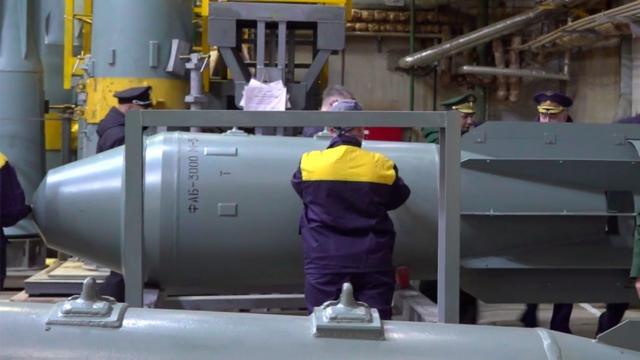
АВТОР ФОТО,“ЗВЕЗДА” Підпис до фото, ФАБ-3000 на недавніх російських відео
Поки що про виробництво повністю нових ФАБ-3000 не йдеться. Старі радянські авіабомби розконсервовують, перевіряють вибухову речовину, якщо треба змінюють, випробовують різні модулі корекції з різних партій.
Лита частина – з чавуну, з товстими стінками. Там мало що потрібно робити з нуля – хіба що детонатори.
Кидати їх можуть одразу по дві з одного борту, як у кінці Афганської війни – тоді, вже після виведення радянських військ, такими авіабомбами працював 185-й гвардійський полк з Полтави на тих самих Ту-22М3.
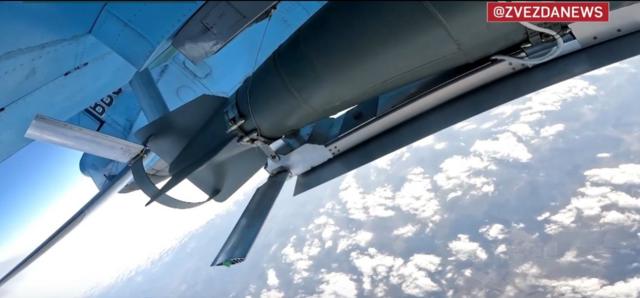
АВТОР ФОТО,“ЗВЕЗДА”
Після скидання з літака бомба перетворюється на ракету без двигуна – її можна перехопити ППО.
Востаннє ФАБ-3000 росіяни діставали під час облоги Маріуполя. Тоді ще не йшлося про модулі корекції – вони скидали бомби по району “Азовсталі”, користуючись тим, що змогли зайняти небо над містом.
Але тепер ситуація інша. Навіть якщо росіянам вдасться вставити у бомболюки ТУ-22М3 збільшений габарит ФАБ-3000 з комплексом коригування польоту УМПК, ці літаки до лінії фронту не підходять.
Цей стратегічний бомбардувальник надто помітний в радіолокаційному діапазоні.
Після втрати двох А-50 росіяни навряд чи захочуть ризикувати ще й ТУ-22М3.
Навіщо ФАБ-3000 і де використовуються такі бомби
Навіщо розконсервують ФАБ-3000? Для ударів по щільній забудові.
Краматорсько-Слов’янська агломерація чи Харків – росіяни не дуже приховують свої цілі. Коли буде можливість ізолювати міську забудову, вибити там ППО та почати рівняти квартали із землею – вони це почнуть.
Росіяни зараз найчастіше застосовують КАБи на найгарячіших ділянках фронту – в районі Авдіївки, Бахмута, Кринок, Куп’янського напрямку.
Тобто скрізь, де росіяни намагаються тиснути і мають можливість застосовувати прифронтову бомбардувальну авіацію.
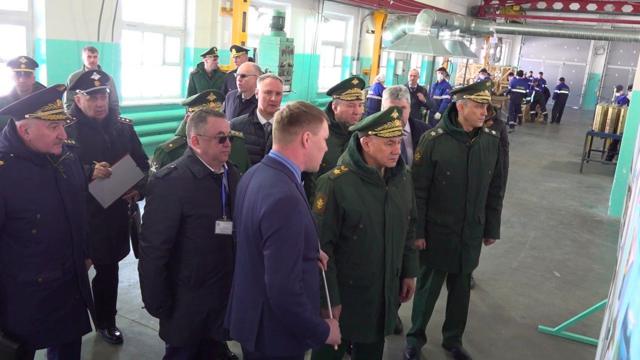
АВТОР ФОТО,“ЗВЕЗДА”
Також РФ регулярно застосовує керовані авіабомби на північному сході України – у прикордонній смузі від Чернігівщини до Харківщини. Насамперед багато останнім часом – на Сумщині.
Для Харкова та інших регіонів небезпека КАБів постане у випадку пригнічення або відсутності ППО ближнього чи середнього радіусу дії. Це дасть змогу російській авіації наблизитися на достатню відстань для скидання авіабомб.
Чи можна з ними боротися?
Приклад українського плацдарму в Кринках показує, що можна. Попри те, що селище перетворено на руїни, колапсу оборони сил ЗСУ там не сталося.
В Кринках справді важко, насамперед з евакуацією – забирати людей човном під діями FPV та артилерії непросто. Але маневри, мережа спостережних пунктів, розосередження невеликих складів “останнього кілометра”, акцент на постачання “з коліс” допомагає ЗСУ.
Повернемось до загальної статистики. З початку 2024 року російські літаки скинули на позиції Сил оборони понад 3500 авіабомб. Це у 16 разів більше у порівнянні з 2023 роком.
За три поточні місяці – 40 бомб на добу. Були дні затишшя, а були й такі, коли скидали 150 бомб, як-от на піку наступу на Авдіївку, у вузькій смузі.
Але в середньому – це 40 авіабомб щодня.
Бомби скидають на ферми на Херсонщині, і на райони, куди пристають човни, що постачають лівий берег Дніпра біля Кринок. А також на Авдіївку, Красногорівку, ТЕС, села Сумщини. І навіть на Бєлогордщині, де росіянам довелося вибивати РДК з села Козинка.
Чи можна умовним десятком прильотів прорвати зону відповідальності батальйону в дві смуги, на яких два десятки “опорників”? Ні.
У випадку, коли десь успішно прилетить, росіяни не факт, що встигнуть використати це влучання – до цього сектору української оборони підійде маневрена група, допоможуть сусіди. Особливо якщо позицію копали правильно.
В Афганістані моджахеди влаштовували мережу постів, які засікали борти, що йдуть на скидання ФАБів і подавали сигнали димом – це означало, що хоч де б ти був, треба негайно змінити позицію.
Російські УМПК мають недолік – у них вбивають координати, і на цьому з коригуванням все завершується.
І в Україні попередження про ракетну небезпеку та КАБи працює.
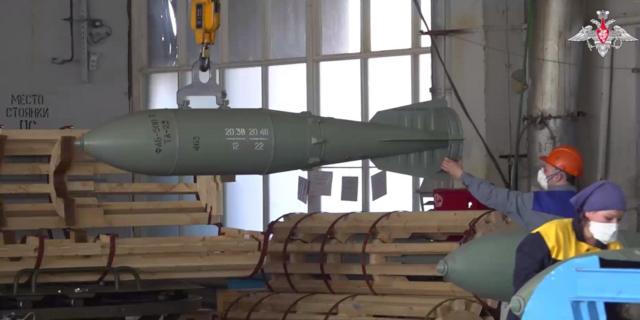
АВТОР ФОТО,МІНОБОРОНИ РФ Підпис до фото, ФАБ-500
Звісно, бомби ФАБ-3000 завдаватимуть втрат ЗСУ. Росія хоче компенсувати низьку точність потужністю.
Але це не “геймченджер”. Потенціал бомб ФАБ-3000 обмежений можливостями носія і тим, що РФ не може придушити українську ППО, не має спеціальних літаків РЕБ.
А з постачанням F-16 та достатньої кількості плануючих бомб JDAM для України ситуація вирівняється. Бомби великої потужності Москва масово застосовувати не зможе.

